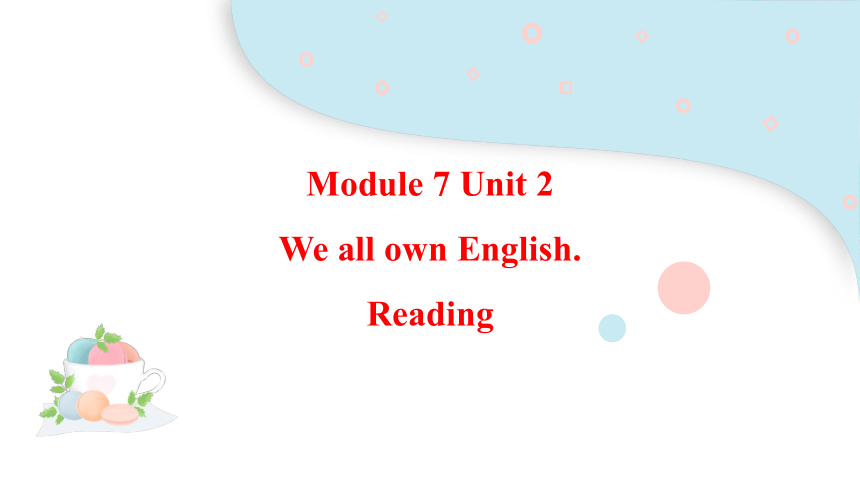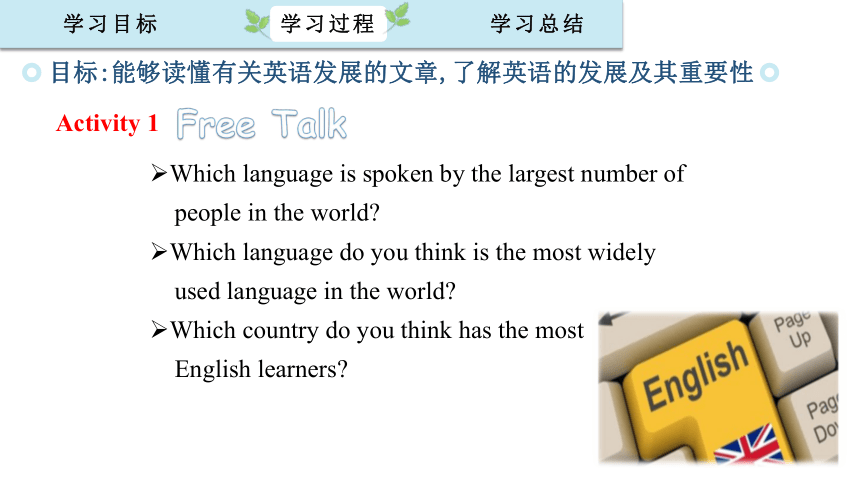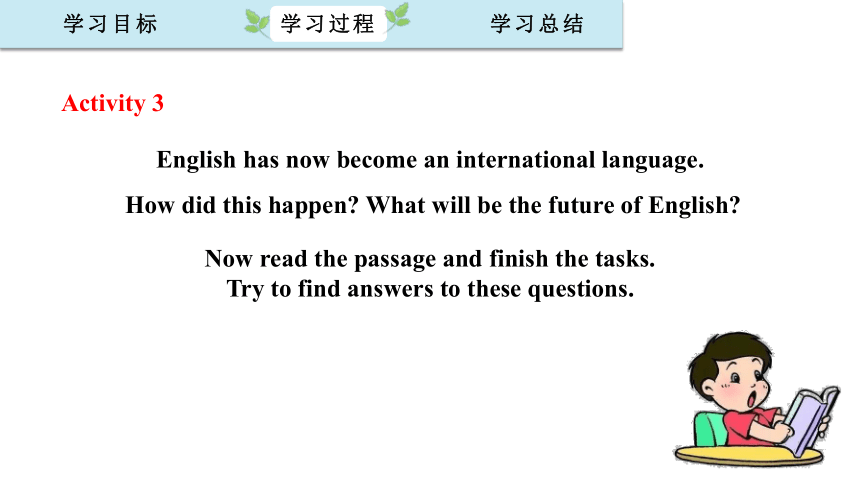Module 7 Unit 2 We all own English Reading课件+音视频(共24张PPT)外研版九年级下册
文档属性
| 名称 | Module 7 Unit 2 We all own English Reading课件+音视频(共24张PPT)外研版九年级下册 |  | |
| 格式 | pptx | ||
| 文件大小 | 51.2MB | ||
| 资源类型 | 教案 | ||
| 版本资源 | 外研版 | ||
| 科目 | 英语 | ||
| 更新时间 | 2025-04-27 20:39:21 | ||
图片预览









文档简介
(共24张PPT)
Module 7 Unit 2
We all own English.
Reading
Let's enjoy a song and try to follow it.
1
2
能记住并正确运用本课时的新单词和短语。
能根据任务导向自主阅读, 能够读懂有关英语发展的文章, 了解英语的发展及其重要性。
目标:能够读懂有关英语发展的文章,了解英语的发展及其重要性
Activity 1
Free Talk
Which language is spoken by the largest number of
people in the world
Which language do you think is the most widely
used language in the world
Which country do you think has the most
English learners
India
America
Canada
New Zealand
Australia
South Africa
the UK
Ireland
Singapore
English is used by nearly a quarter of the world’s population.
America
English development
Word Trade
(in the 19th century)
Spread English
(in the 20th century)
Common language
(travel/science/industry…)
Activity 2
1
Work in pairs. Talk about the photos below. Say:
where they are what languages you can see
a
b
c
China
English, Chinese
English
India
Korea
Korean, English
Activity 3
English has now become an international language.
How did this happen What will be the future of English
Now read the passage and finish the tasks.
Try to find answers to these questions.
Task 1: Read the passage quickly, then match the ideas with
the paragraphs.
v
a) Chinese may be the next world language in the future. ______
b) English is the most important international language today. ______
c) English spread through trade and the media. ______
d) We all own English. ______
e) English has borrowed many words from other languages. ______
Para. 4
Para. 1
Para. 2
Para. 5
Para. 3
Task 2: Read the questions again, then scan the passage and answer them.
1. How many people in the world use English
2. How did English become an international language
3.When do you think Chinese will become an international language
4.Who owns English
About 400 million people.
In the 19th century, English became the language of world trade. In the 20th century, the US spread English to the world.
By the middle of the 21st century.
Everyone who speaks English.
v
Task 3.1: Read paragraph 1 carefully and choose the T/F.
1. English is spoken by about 400 million people, and is
used by a half of the world's population. _____
2. In Ghana, India and Singapore, people only use English
every day. _____
3. In China, English is learned as the most important
foreign language. _____
F
F
T
quarter
as a working language
Task 3.2: Read paragraph 2 carefully and fill the blanks.
Because
(1) in the 19th century, English became
________________________;
(2) in the 20th century, the US
_________________________ through
___________________________.
Why is English spoken everywhere
the language of world trade
spread English to the world
newspapers, television and films
Task 3.3: Read paragraph 3 carefully and fill in the chart.
borrowed words from other languages words borrowed from
restaurant
zero
piano
tofu
French
Arabic
Italian
Chinese
Task 3.4: Read paragraph 4 carefully and choose the correct answer.
1. When do people think China will become an international
language
A. by the middle of the 21st century
B. by the middle of the 20th century
2. What do some European schools teach
A. only Chinese
B. Chinese together with some European languages
3. Most people that English will be used around the world ______.
A. in a few years
B. at least for the next twenty or thirty years.
Task 3.5: Read paragraph 5 carefully and answer the questions.
1. Do people speak different types of English around
the world
2. Who owns English
Yes, they do.
English is owned by everyone who speaks it.
Activity 4
Work in groups. Find out some language points that you think are important and share their use with your classmates and give some examples.
Language points:_______________________
_____________________________________
_____________________________________
____________________________________
_____________________________
Language points
1. English is now used by nearly a quarter of the world’s population,
and anywhere you go in the world, there is a good chance that you
will meet someone who speaks English.
(1) quarter 意为“四分之一”;分数作主语时,谓语动词要与其后
名词的单复数保持一致。
e.g. A quarter of the water is dirty.
Three quarters of the residents are over 55 years old.
(2) population 意为“人口, 人口数量”。作主语时, 谓语动词一般用
第三人称单数形式。
e.g. The population of the UK is smaller that that of China.
【拓展】
①询问某地的人口数量时用句型“What’s the population of… ”
或“How large is the population of… ”,不能使用how many
或how much提问。
②表示某地有多少人口时, 常用“某地 + has a population of…”,
相当于“The population of + 某地 + is…”。形容人口的多或
少, 用large或small。
e.g. The population of Shanghai is very large.
2. It is also important to know that English has borrowed many words
from other languages…
borrow … from … 意为“从……借……”, 表示借入。
e.g. May I borrow a book from the library
反义短语是lend … to … , 意为“把……借给……”, 表示借出。
e.g. You’d better not lend it to others.
3. More and more schools in Europe are teaching Chinese as a foreign
language, together with some European languages.
together with … 意为“与……一起,连同……”。
e.g. He sent her some books, together with a photo.
together with 连接前后两个主语时, 谓语动词要与之前的主语在人称
和数上保持一致。
e.g. Mr Smith together with his parents is going to Shanghai next week.
4. The answer is everyone who speaks it—the British, the Indians
and the Chinese all help make it a rich language.
(1) Indian 此处用作名词, 意为“印度人”。还可以作形容词,
意为“印度的; 印度文化的; 印度人的”。
e.g. She is an Indian girl.
(2) help 后面跟动词不定式作宾语时, 不定式符号to可以省略。
e.g. I often help my mum (to) do housework.
5. Even though we speak different types of English, we are all
part of an international club.
even though 意为“虽然, 尽管”, 相当于even if, 多用于书面语中。
even if 和 even though 均可用于引导让步状语从句。
e.g. He went on working even though / if he was very tired.
Activity 5
4
Complete the questions with the words in the box.
boss India quarter secretary zero
1. Does a private _________ work for a manager or a teacher
2. Does a(n) _________ look after office workers or work alone
3. What are the people who live in ________ called
4. How many times does ________ appear in 1,000 and 1,000,000
5. If 1.75 billion is a(n) ________ of the world’s population, what’s the
whole population of the world
boss
India
secretary
zero
quarter
Now work in pairs. Ask and answer.
teaching Chinese as a foreign language
international travel, science, industry, and recently,
information technology and the Internet
used as a working language
communicate with each other
in the 20th century
Fill in the blanks and
retell the passage.
Module 7 Unit 2
We all own English.
Reading
Let's enjoy a song and try to follow it.
1
2
能记住并正确运用本课时的新单词和短语。
能根据任务导向自主阅读, 能够读懂有关英语发展的文章, 了解英语的发展及其重要性。
目标:能够读懂有关英语发展的文章,了解英语的发展及其重要性
Activity 1
Free Talk
Which language is spoken by the largest number of
people in the world
Which language do you think is the most widely
used language in the world
Which country do you think has the most
English learners
India
America
Canada
New Zealand
Australia
South Africa
the UK
Ireland
Singapore
English is used by nearly a quarter of the world’s population.
America
English development
Word Trade
(in the 19th century)
Spread English
(in the 20th century)
Common language
(travel/science/industry…)
Activity 2
1
Work in pairs. Talk about the photos below. Say:
where they are what languages you can see
a
b
c
China
English, Chinese
English
India
Korea
Korean, English
Activity 3
English has now become an international language.
How did this happen What will be the future of English
Now read the passage and finish the tasks.
Try to find answers to these questions.
Task 1: Read the passage quickly, then match the ideas with
the paragraphs.
v
a) Chinese may be the next world language in the future. ______
b) English is the most important international language today. ______
c) English spread through trade and the media. ______
d) We all own English. ______
e) English has borrowed many words from other languages. ______
Para. 4
Para. 1
Para. 2
Para. 5
Para. 3
Task 2: Read the questions again, then scan the passage and answer them.
1. How many people in the world use English
2. How did English become an international language
3.When do you think Chinese will become an international language
4.Who owns English
About 400 million people.
In the 19th century, English became the language of world trade. In the 20th century, the US spread English to the world.
By the middle of the 21st century.
Everyone who speaks English.
v
Task 3.1: Read paragraph 1 carefully and choose the T/F.
1. English is spoken by about 400 million people, and is
used by a half of the world's population. _____
2. In Ghana, India and Singapore, people only use English
every day. _____
3. In China, English is learned as the most important
foreign language. _____
F
F
T
quarter
as a working language
Task 3.2: Read paragraph 2 carefully and fill the blanks.
Because
(1) in the 19th century, English became
________________________;
(2) in the 20th century, the US
_________________________ through
___________________________.
Why is English spoken everywhere
the language of world trade
spread English to the world
newspapers, television and films
Task 3.3: Read paragraph 3 carefully and fill in the chart.
borrowed words from other languages words borrowed from
restaurant
zero
piano
tofu
French
Arabic
Italian
Chinese
Task 3.4: Read paragraph 4 carefully and choose the correct answer.
1. When do people think China will become an international
language
A. by the middle of the 21st century
B. by the middle of the 20th century
2. What do some European schools teach
A. only Chinese
B. Chinese together with some European languages
3. Most people that English will be used around the world ______.
A. in a few years
B. at least for the next twenty or thirty years.
Task 3.5: Read paragraph 5 carefully and answer the questions.
1. Do people speak different types of English around
the world
2. Who owns English
Yes, they do.
English is owned by everyone who speaks it.
Activity 4
Work in groups. Find out some language points that you think are important and share their use with your classmates and give some examples.
Language points:_______________________
_____________________________________
_____________________________________
____________________________________
_____________________________
Language points
1. English is now used by nearly a quarter of the world’s population,
and anywhere you go in the world, there is a good chance that you
will meet someone who speaks English.
(1) quarter 意为“四分之一”;分数作主语时,谓语动词要与其后
名词的单复数保持一致。
e.g. A quarter of the water is dirty.
Three quarters of the residents are over 55 years old.
(2) population 意为“人口, 人口数量”。作主语时, 谓语动词一般用
第三人称单数形式。
e.g. The population of the UK is smaller that that of China.
【拓展】
①询问某地的人口数量时用句型“What’s the population of… ”
或“How large is the population of… ”,不能使用how many
或how much提问。
②表示某地有多少人口时, 常用“某地 + has a population of…”,
相当于“The population of + 某地 + is…”。形容人口的多或
少, 用large或small。
e.g. The population of Shanghai is very large.
2. It is also important to know that English has borrowed many words
from other languages…
borrow … from … 意为“从……借……”, 表示借入。
e.g. May I borrow a book from the library
反义短语是lend … to … , 意为“把……借给……”, 表示借出。
e.g. You’d better not lend it to others.
3. More and more schools in Europe are teaching Chinese as a foreign
language, together with some European languages.
together with … 意为“与……一起,连同……”。
e.g. He sent her some books, together with a photo.
together with 连接前后两个主语时, 谓语动词要与之前的主语在人称
和数上保持一致。
e.g. Mr Smith together with his parents is going to Shanghai next week.
4. The answer is everyone who speaks it—the British, the Indians
and the Chinese all help make it a rich language.
(1) Indian 此处用作名词, 意为“印度人”。还可以作形容词,
意为“印度的; 印度文化的; 印度人的”。
e.g. She is an Indian girl.
(2) help 后面跟动词不定式作宾语时, 不定式符号to可以省略。
e.g. I often help my mum (to) do housework.
5. Even though we speak different types of English, we are all
part of an international club.
even though 意为“虽然, 尽管”, 相当于even if, 多用于书面语中。
even if 和 even though 均可用于引导让步状语从句。
e.g. He went on working even though / if he was very tired.
Activity 5
4
Complete the questions with the words in the box.
boss India quarter secretary zero
1. Does a private _________ work for a manager or a teacher
2. Does a(n) _________ look after office workers or work alone
3. What are the people who live in ________ called
4. How many times does ________ appear in 1,000 and 1,000,000
5. If 1.75 billion is a(n) ________ of the world’s population, what’s the
whole population of the world
boss
India
secretary
zero
quarter
Now work in pairs. Ask and answer.
teaching Chinese as a foreign language
international travel, science, industry, and recently,
information technology and the Internet
used as a working language
communicate with each other
in the 20th century
Fill in the blanks and
retell the passage.
同课章节目录
- Module 1 Travel
- Unit 1 We toured the city by bus and by taxi
- Unit 2 It's a long story.
- Unit 3 Language in use
- Module 2 Education
- Unit 1 They don't sit in rows.
- Unit 2 What do I like best about school?
- Unit 3 Language in use
- Module 3 Life now and then
- Unit 1 They sometimes work harder.
- Unit 2 I think life is better today.
- Unit 3 Language in use.
- Module 4 Rules and suggestions
- Unit 1 You must be careful of falling stones.
- Unit 2 we must keep the camp clean.
- Unit 3 Language in use.
- Revison A
- Module 5 Look after yourself
- Unit 1 We'd better get you to hospital.
- Unit 2 Get off the sofa!
- Unit 3 Language in use.
- Module 6 Eating togethe
- Unit 1 When is the school-leavers' party?
- Unit 2 Knives and forks are used for most Western
- Unit 3 Language in use
- Module 7 English for you and me
- Unit 1 Have you ever been to an English corner?
- Unit 2 We all own English.
- Unit 3 Language in use
- Module 8 My future life
- Unit 1 Here's to our friendship and the future
- Unit 2 I know that you will be better at maths.
- Unit 3 Language in use
- Revison B
